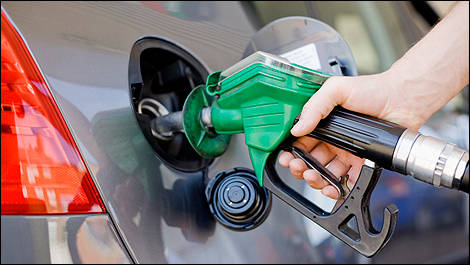About 99% of the time I test new vehicles, my observed fuel economy average is higher than what the manufacturer flaunts. In some cases, my combined average is close to the city figure; the rest of the time, it’s off by at least 1 L/100km.
When a manufacturer publishes the fuel economy ratings for its new vehicles, they must follow Natural Resources Canada’s test procedures, so everyone’s on the same page for comparative purposes. It’s those procedures that are out of whack with today’s reality.
The procedure for calculating the city fuel consumption rating is as follows, taken out of NRCan’s Fuel Consumption Guide:
“The city test simulates a 12-km, stop-and-go trip with an average speed of 32 km/h and a top speed of 91 km/h. The test runs for 23 minutes and includes 18 stops. About four minutes of test time are spent idling, to represent waiting at traffic lights. The test begins from a cold engine start, which is similar to starting a vehicle after it has been parked overnight during the summer. When the test is completed, the test cycle starts again with a hot engine start, and the first eight minutes of the test are repeated. This simulates restarting a vehicle after it has been warmed up, driven and then stopped for a short time.”
Here’s the procedure for the highway rating:
“The highway test simulates a 16-km trip with an average speed of 77 km/h and a top speed of 97 km/h. The test runs for 13 minutes and does not include any stops. However, the speed varies to simulate different kinds of highway and rural roads. The test begins from a hot engine start.”
The tests are performed in a laboratory using a two-wheel dynamometer. NRCan also specifies that 4x4 or AWD vehicles are tested in two-wheel drive mode, another factor that can skew the results.
Seriously, does the city procedure seem familiar to your typical daily commute? And who drives 77 km/h on the highway? No one.
Are you getting it? To obtain the best fuel economy results, you should drive your vehicle between 70 and 80 km/h, using the highest possible gear. If you drive at the posted highway speed limit of 100 km/h, your vehicle’s engine will most likely be revving at a higher rpm, and fuel consumption will go up.
The US fuel consumption ratings, revised in 2008 with a stricter procedure that incorporates real-world effects such as faster speeds and acceleration, use of A/C and colder outside temperatures, are much more realistic.
The difference between Canadian and US figures vary from vehicle to vehicle. Here are some examples:
When a manufacturer publishes the fuel economy ratings for its new vehicles, they must follow Natural Resources Canada’s test procedures, so everyone’s on the same page for comparative purposes. It’s those procedures that are out of whack with today’s reality.
 |
The procedure for calculating the city fuel consumption rating is as follows, taken out of NRCan’s Fuel Consumption Guide:
“The city test simulates a 12-km, stop-and-go trip with an average speed of 32 km/h and a top speed of 91 km/h. The test runs for 23 minutes and includes 18 stops. About four minutes of test time are spent idling, to represent waiting at traffic lights. The test begins from a cold engine start, which is similar to starting a vehicle after it has been parked overnight during the summer. When the test is completed, the test cycle starts again with a hot engine start, and the first eight minutes of the test are repeated. This simulates restarting a vehicle after it has been warmed up, driven and then stopped for a short time.”
Here’s the procedure for the highway rating:
“The highway test simulates a 16-km trip with an average speed of 77 km/h and a top speed of 97 km/h. The test runs for 13 minutes and does not include any stops. However, the speed varies to simulate different kinds of highway and rural roads. The test begins from a hot engine start.”
The tests are performed in a laboratory using a two-wheel dynamometer. NRCan also specifies that 4x4 or AWD vehicles are tested in two-wheel drive mode, another factor that can skew the results.
Seriously, does the city procedure seem familiar to your typical daily commute? And who drives 77 km/h on the highway? No one.
Are you getting it? To obtain the best fuel economy results, you should drive your vehicle between 70 and 80 km/h, using the highest possible gear. If you drive at the posted highway speed limit of 100 km/h, your vehicle’s engine will most likely be revving at a higher rpm, and fuel consumption will go up.
The US fuel consumption ratings, revised in 2008 with a stricter procedure that incorporates real-world effects such as faster speeds and acceleration, use of A/C and colder outside temperatures, are much more realistic.
The difference between Canadian and US figures vary from vehicle to vehicle. Here are some examples:
| Model | Canadian ratings | US ratings | Converted US ratings | Combined difference |
2012 Mazda2 with 4-speed automatic | 7.1/5.8 L/100km | 28/34 MPG US | 8.4/6.9 L/100km | 18.6% |
| 2012 Toyota Prius v | 4.3/4.8 L/100km | 44/40 MPG US | 5.3/5.9 L/100km | 23.1% |
| 2012 Chevrolet Silverado 1500 4WD with 5.3L V8 | 14.3/9.4 L/100km | 15/21 MPG US | 15.7/11.2 L/100km | 13.1% |
| 2012 Porsche Panamera Turbo S | 14.1/8.6 L/100km | 15/23 MPG US | 15.7/10.2 L/100km | 13.8% |
Natural Resources Canada should follow the US’ lead within the next few years, and it’s about time.


